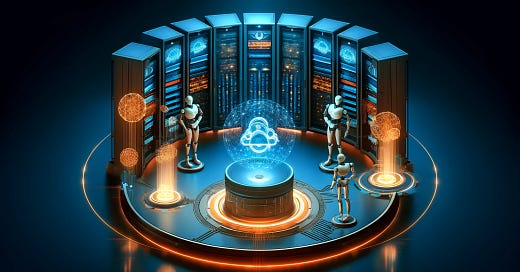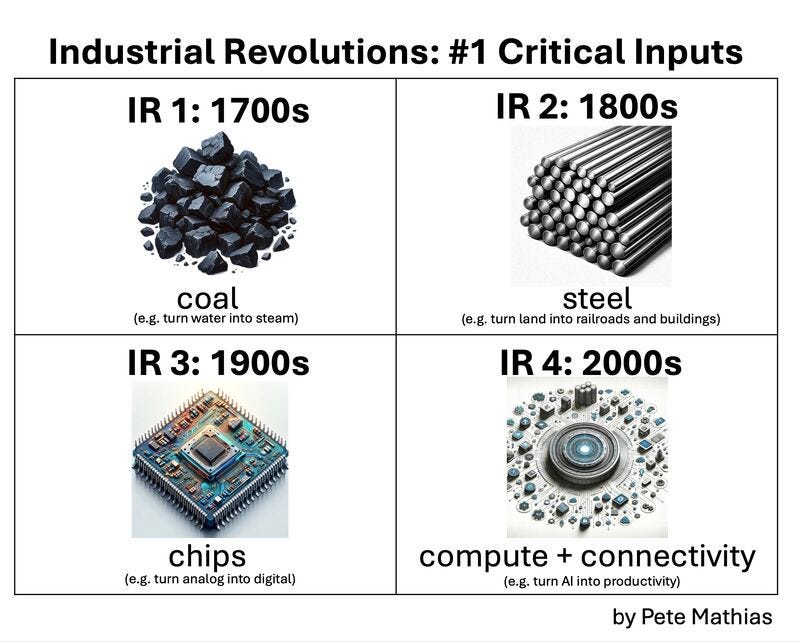Hi everyone,
The next Industrial Revolution has arrived. Like past IRs, this one will have a critical input (a “coal”). What is it?
Drum roll please 🥁,
Pete
ps: as always, awesome jobs at awesome startups below!
Looking back: Past IRs
Every industrial revolution has a critical input that fueled the revolution.
In the 1st Industrial Revolution (1IR) in the 1700s, it was coal. Moving from manual labor to mechanization required coal to, for example, turn water into steam.
In the 2nd Industrial Revolution (21R) in the 1800s, it was steel. The move to mass production made steel indispensable for building infrastructure and machinery, thanks to its durability and scalability.
In the late 1900s, the 3rd Industrial Revolution (3IR) introduced a shift to digital production, making semiconductors critical for computing, telecon, and consumer electronics.
Now here we are 20+ years into the 2000s, it is clear what the dominant critical input will be of the 4th Industrial Revolution (4IR): compute and connectivity.
Altman: “Currency of Future”
Open AI’s Sam Altman calls compute the “currency of the future.” It will be fundamental. Think of it like building a spaceship. You need a powerful engine (compute) to propel you through the cosmos, but you also need a robust communication system (connectivity) to navigate the vast unknown. Without both, you're stuck grounded. In one particular place, these 2Cs are essential: on the edge– or the places where data is generated. Examples include a factory utilizing IoT devices to monitor machinery in real-time, a hospital deploying wearable devices for patient monitoring to ensure immediate medical intervention, and a farm using sensors and drones for precision agriculture to track crop health and soil moisture levels.
Edge: “Next frontier of Digital Transformation”
In the words of Intel, “The edge is the next frontier of digital transformation, being further fueled by AI, according to Pallavi Mahajan, Intel Corporate Vice President of Network and Edge Group Software.
These edge capabilities encompass a spectrum of technological domains, including cloud and edge computing, AI, 5G, IoT, and cybersecurity. All are integral to powering and securing the interconnected digital ecosystem of the 4IR.
Anomalies of IR4: Timing and Tempo
But unlike past revolutions, we don’t have as much time to build that infrastructure. While the steel-built railroads took decades, we really only have days, weeks, months to keep up with the compute-voracious apps from AI to AR/VR. Without advancements in compute and connectivity, we will have only a partial revolution. Manufacturing, for example, will be left further behind.
Turning data into productivity requires secure, dense networks and computational power. The good news: we have the pieces– 5G, WiFi6, satellite constellations, for example– but we will need more investment.
Massive TAM: A Torrent of Innovation Coming
This is a massive market. McKinsey estimates that by 2025, Industry 4.0 will reach $3.7 trillion– the analysis predicts that companies embracing Industry 4.0 technologies could see a 122 percent cash flow increase by 2025, while non-adopters face a 23 percent decrease.
With favorable economics and now tech breakthrough use-cases in generative AI and novel AR/VR consumer rollouts, we are– in manufacturing– about to see a torrent of disruption that unlocks productivity. Startups are preparing to build that future by building connectivity and compute solutions.
Consider what the CEO and co-founder of Edgescale AI, Brian Mengwasser says:
“We know that GDP gains in the AI era come from inference which consumes huge volumes of operational data. Demand for inference, the operational data it requires IoT devices that generate that data are all growing exponentially. Exponential data requires suitable high density networks. True to its name, this revolution requires us to entirely rethink and reinvent how we scale compute and handle such volumes.”
Illustrative Startups in Connectivity + Compute
Innovators are enhancing connectivity through solutions in cloud networking, real-time IoT tracking, process analytics, energy-conscious computing, embedded machine learning, customizable computation stacks, and high-speed internet services, driving forward a transformative technological landscape. There is an ecosystem growing. Here are just a few examples of exciting trailblazers in edge:
Alkira: provides a cloud networking solution to seamlessly connect different networks, enhancing multi-cloud network provisioning and visibility.
Armada Logistics: provides a connected solution to track shipments in transit, using IoT to offer real-time updates and deep learning for delivery impact analysis.
Celonis: provides cloud-based process mining and execution management software to analyze business processes in real-time and improve operational efficiency with predictive analytics.
Crusoe: offers cloud-based AI solutions to reduce natural gas flaring in the oil and gas industry by converting waste gas into energy for advanced computing systems.
Edge Impulse: offers AI and cloud services to build embedded machine learning applications, supporting industries from consumer devices to enterprise solutions.
EnCharge: EnCharge delivers AI computation stack solutions with customizable hardware and software to meet diverse application needs.
Vapor: Vapor works with big internet and cable companies to create super-fast internet services right near businesses, making it easier and faster for them to use online services without having to manage a bunch of computer servers on their own.
Looking Forward
As visionary as these startups are, their visions will not be possible unless we invest into their backbone use cases. Just as new infrastructure - railways, foundries, and power plants - was needed to reach a thriving second Industrial Revolution, our infrastructure needs an upgrade to realize 4IR. Wooden carriages and brick roads of the past won’t cut it.
As always, curious your thoughts— thanks for reading!
Pete
PS: Originally published via AV here— and tune into my upcoming talk on this!
Pete’s Picks: Cool Jobs, Cool Companies
There are open positions at some really cool companies. Check them out:





